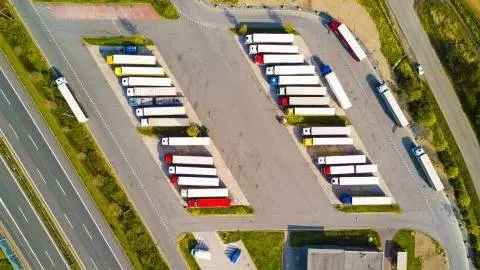European truck market heading for recovery after short pandemic plunge
The European truck market is continuing to recover, with new registrations expected to rebound by 18% this year after a 27% plunge in 2020. Supply side delays following disruptions and shortages will slow the upward trend, but order books suggest the recovery will last into 2022
European road transport on its way back
The European road transport sector recovered surprisingly well from the pandemic lows of spring 2020. The sector was affected unevenly by different lockdown measures across countries, but following a shift in consumption from services to goods, general volumes rebounded more quickly than many expected and surging e-commerce led to extra transport activity. With fairly stable or even lower costs, 2020 was also better than expected financially.
German motorway mileage (MAUT) exceeded its 2019 cumulative level again from March 2021 onwards, which indicates that activity is now pretty much back on track. At the European level, we expect road transport performance to largely recover to pre-pandemic levels in FY 2021 (graph).
Slow down in transport halted truck fleet development

Expansion of the European fleet stagnated in 2020
The European truck fleet expanded less than transport volume growth in the pre-pandemic years. Poland (+17%) and Romania (+24%) showed the largest growth in rolling stock, following the shift of international transport towards Eastern Europe. This turned Poland into Europe’s largest road transport country, the base for 1.15 million registered heavy duty trucks (> 3.5 ton). The new inflow of trucks was low last year and the fleet may have gone down slightly. However, excess capacity remains limited on average, leaving room for some fleet expansion once transport growth resumes.
European truck registrations dropped sharply in biggest European markets
European heavy duty truck sales dropped sharply in 2020, ending 27% below 2019 levels at just below 300,000 units. In the three largest European markets, the biggest drop was seen in the UK, which experienced a strong lockdown. The Netherlands and Belgium also saw a more than 30% decline. Remarkably, Southern European countries held up relatively well. One reason for this is probably the weak sales figures seen in the pre-pandemic years.
Largest 3 European truck markets behind in recovery

Truck market rebounds but 2021 won’t bring a full recovery to 2019 levels
Following the return of European road transport volumes and business confidence, investment in new trucks picked up strongly in the run up to 2021. Large fleet owners, in particular, placed new orders, with a major order for 1,300 DAF trucks coming from the Spanish road transport company Primafrio, for example. Truck manufacturers' order books at mid-year are pretty well filled again.
This has led to a 32% rebound in registrations in the first five months of 2021 compared to the same period last year. For the full year 2021, we expect truck registrations in Europe to rebound by 18% to 350,000 which is still well below the 2019 level, but close to the seven-year average, a common leasing term for new trucks.
Registrations in Poland picked up relatively well and returned to pre-pandemic levels in the first half of 2021. This is remarkable as the European Commission's mobility package forces drivers to return home periodically, triggering more registrations in countries closer to the western European goods flow. Periodic repatriating of trucks under European law is being reconsidered, however, as this will lead to more inefficiency.
European truck sales show partial recovery in 2021, continued in 2022

Truck sales to suffer less than during the financial crisis
The recovery of truck sales after the pandemic downturn started earlier than during the slump following the global financial crisis in 2009. While registrations were coming down from all-time highs in the GFC, significant stocks of newly built trucks were still being created. That was not the case this time, with the market losing steam earlier and stocks at minimum levels. This is contributing to the current uptake. The UK truck market, in particular, might benefit from more locally-based transport activity post-Brexit, although the country faces a driver shortage.
Production challenges lead to longer lead times and temper new registrations in 2021
Daily truck production from European manufacturer DAF (part of Paccar) is back on track this year. This is a sign of recovery, although the backlog after the pandemic interruptions in the spring of 2020 pushed up production at an early stage. While manufacturers speak of filled order books, production capacity faces challenges due to long lead times for supplies ranging from steel components to plastics parts to tires. Most critical are chip shortages, which forced Volvo Ghent to halt production for a week in February. Chips have become a crucial input for trucks amid increasing demand for advanced driver systems and connected vehicles. Manufacturers generally try to work around this, but the threat to production schedules remains over the coming quarters. Together with fairly strong order books, this leads to significantly longer lead times, tempering new truck registrations in 2021, with spillover effects for 2022.
Production DAF-trucks at European plants exceeded pre-crisis level in spring 2021

European truck market dominated by seven brands
The European truck market is dominated by seven brands, part of Daimler (Mercedes), Paccar (DAF), Volvo trucks, Traton (Scania, MAN), Iveco (CNH Industrial) and Renault group. The market doesn't change significantly from year to year, although the market share of big brands (in terms of units sold) has become more aligned over the years.
Mercedes still leads the European truck market, the big five cover 80%

Paccar and Volvo trucks are two out of six companies dominating the European heavy truck market. We have a look at their financial performance and the way forward:
Paccar
Paccar said that customer demand for its trucks was "very strong" and that truck deliveries increased in the first quarter of 2021 sequentially, in spite of the constrained supply of semiconductors affecting the auto sector. In 1Q 2021, the company had consolidated net sales and revenues of $5.85bn, up 13.3% year-on-year (YoY), with sales up strongly, by 12.7%, for its key Truck segment (new truck deliveries of 42,200 in the reported quarter, +9.9% YoY), while an Aftermarket Parts segment had a record quarterly revenue, up 16.2% YoY.
Paccar commented that freight tonnage was strong in the first quarter of this year as the US economy continued to recover, with trucks accounting for nearly three-quarters of the freight transported in the country, based on the 2020 numbers. The company's Kenworth and Peterbilt's Class 8 truck orders increased nearly three-fold year-on-year in 1Q 2021 in the US and Canada.
Earlier in the year, Paccar also launched new heavy- and medium-duty truck models which offer higher fuel efficiency and advanced driver assistance systems (ADAS). Importantly, DAF started manufacturing CF Electric trucks during the month of April. Kenworth and Peterbilt are expected to launch zero emissions truck production in the coming months. In 1Q 2021, Paccar began producing battery electric customer trucks for applications such as port, refuse and local deliveries. In these applications, trucks return to depots for recharging each day and have a calibrated range to optimise battery weight and cost. Recently, on 9 June, DAF announced it was launching a new generation of trucks, with improved fuel efficiency (up to 10% higher fuel efficiency and an equivalent reduction in CO2 emissions), enhanced safety features and additional comfort features for drivers. The production of this new generation of trucks is due to start in October.
Volvo Group
Volvo Group commented that the first quarter of 2021 was marked by a high level of activity among its customers, including a strong freight market, with increased transported volumes, driven by e-commerce, among other factors. As a result, the company's customers realised higher freight prices and achieved improved profitability, prompting them to expand their fleets to meet increased demand. Consequently, there was a strong order intake in Volvo Group's truck segment. The company noted that inventories of both new and used trucks were low globally and Volvo Group increased deliveries by 17% YoY in 1Q 2021, raising its profitability as well (with the company's operating margin more than doubling to 12.8% in the first quarter of this year, from 6.8% in the respective prior-year quarter). Volvo Group noted that the global semiconductor supply constraints had a limited impact on the company's production in 1Q 2021 while the company expected to lose production equivalent to two to four weeks of the international production, depending on the manufacturing site, during 2Q 2021 and further disruptions cannot be ruled out. Recently, the press reported that the company was halting production at its Ghent factory for the week of the 21 June due to a shortage of semiconductors.
Volvo Group noted that it continued to invest in the electrified, automated and connected technological solutions and the company already has fully electric trucks, buses and construction equipment in serial production. While presently volumes remain small, there is high customer interest in the products and with the expected rollout of the heavy-duty electric trucks by both Volvo Trucks and Renault Trucks in the next two years, the group would offer electric trucks with ranges that cover almost half of the truck transports carried out in the EU. In 1Q 2021, Volvo group also created a new joint fuel cell company called CellCentric in cooperation with Daimler Truck, aiming to make it a leading global manufacturer of fuel cells. In March, Renault Trucks outlined its further ambitions for electric mobility, targeting the all-electric Renault Trucks' offer for each segment - distribution, construction and long-distance transport - from the year 2023. In April, Volvo Trucks announced the start of sales of three new heavy-duty all-electric models later this year.
During 1Q 2021, Volvo Group had sales of SEK94,018mn, up 2.8% YoY on a reported basis but up 13% when adjusted for foreign exchange movements, helped by a robust increase in vehicle sales. The demand for trucks was broad based across segments both in Europe and North America, with truck fleet utilisation back to the pre-Covid-19 levels and demand for spare parts and services also strong. The Chinese market grew strongly in 1Q 2021, supported by subsidies to speed up the replacement of vehicles which do not meet the CN3 emissions standards. Chinese market sales grew strongly relative to 1Q 2020, which was severely affected by Covid-19. Other prominent markets, including Japan, India and Brazil also recorded positive dynamics. Volvo Group's total order intake was 85,461 trucks in 1Q 2021, up 123% YoY, and deliveries were 52,444, up 17% YoY. In Europe, order intake of heavy- and medium-duty trucks increased by 126% YoY in the reported quarter (to 39,081), with deliveries of 18,871 (+10% YoY). Truck order intake in North America increased by 369% to 22,215, with deliveries of 12,972 (+22% YoY). South American order intake and deliveries increased by 27% and 13% YoY, respectively.
This publication has been prepared by ING solely for information purposes irrespective of a particular user's means, financial situation or investment objectives. The information does not constitute investment recommendation, and nor is it investment, legal or tax advice or an offer or solicitation to purchase or sell any financial instrument. Read more
Download
Download article
1 July 2021
Truck and trailer markets benefit from soft landing in road transport This bundle contains 3 Articles
